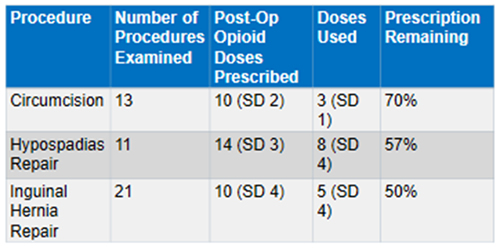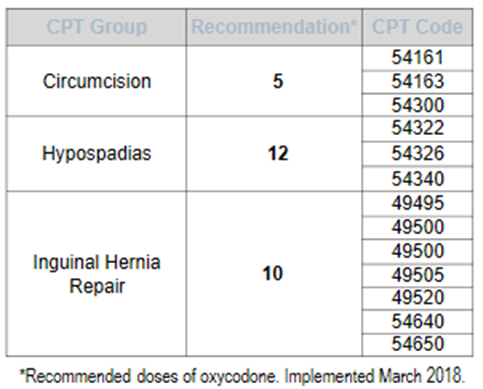Creation of a Standard Opioid Prescribing Schedule for Pediatric Urology Procedures
By Marley B. Lawrence, MD, Peggy P. McNaull, MD, Brooke A. Chidgey, MD, Brandon G. Hammond, MD, Brandon Garren, MD, Sherry S. Ross, MD, Nathan Woody, CSSBB, Karene Ricketts, MD
UNC Department of Anesthesia and Pediatrics, UNC School of Medicine, Chapel Hill, North Carolina
(Summarized and submitted by Marley B. Lawrence, MD)
We assessed opioid prescribing practices of pediatric urologists and patients’ subsequent usage, storage and disposal habits in the postoperative period. We used this data to create a Standard Opioid Prescribing Schedule for common pediatric urology procedures.
Over five months, all children 0-17 years old undergoing urologic procedures at the University of North Carolina were chart reviewed. 113 charts were reviewed and postoperative opioid prescribing practices were identified. Telephone calls were made to the patient's guardian 2-4 weeks following their procedure and a standardized telephone survey was completed. Of the 113 charts reviewed, 67 participated in the survey. 86.6% of patients had filled their opioid prescription; the remaining 13.4% had not filled.

Fig 1. Key Findings about Opioid Counseling, Use and Storage

Fig 2. Opioid Prescribing and Usage Patterns by Procedure

Fig 3. Standard Opioid Prescribing Schedule
Conclusions
- Most patients (80.6%) are prescribed more opioids than needed for post-op pain
- Unused opioids are being improperly disposed of or kept in homes
- Standard Opioid Prescribing Schedule now implemented; provider compliance being tracked
Through data driven efforts to guide opioid prescribing and education, the supply of opioids available for misuse can be minimized, without eliminating availability for those who truly need.


